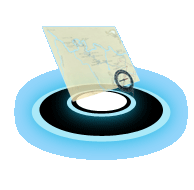|
Before starting on a long trek with only your compass, there should be some information that you should know. At the very least, you should know
what your pace is, and how to determine north without the aid of a compass or a GPS unit.
|
What is a pace?
Is it how fast I can go on a compass course? If it is then I have a really fast pace…Not necessarily. A pace is the distance covered by two steps
or a normal walk. This is used to estimate the distance traveled in a certain direction. It can also be used to estimate the height or width of
objects. Users can easily determine their pace by conducting the following exercise:
- Measure out a distance of 100 feet. This can be done with a 100 foot rope or a measuring tape.
- Starting with your left foot at the end of the rope, walk towards the end of the 100 foot marker. Count the number of times your right foot hits the ground. Each time your right foot hits the ground is consider 1 pace.
- Once completed, divide 100 by the number of paces. This is your distance per pace. For example if you took 20 paces, your distance per pace would be 5 feet (100 foot divided by 20 paces).
Once you have determined your pace you can measure distances by multiplying the number of paces with your calculated distance per pace. Please
keep in mind that your pace may change over time. Your pace can also depend on the terrain and also if you are carrying weight on your back.
Check your pace often to ensure that you have the most accurate information.
|
How to calculate length and height with pacing
Now that you know your pace, there are different methods you can use to determine the height or width of an object where a measuring tape would
just not work. The methods are listed below:
Width:
- Salute Method
- Stick Method
- Compass Method
Height:
- Felling Method
- Stick Method
|
Width
Captain on Deck! - The salute method
A scout can determine the width of an object using the salute method. An example of this is to determine the width of a river before crossing.
The Salute Method works by extrapolating the width of the river 90 degrees so it can be paced out by the user. To do this, follow the steps below:
1. Stand on the side of the river looking towards the opposite side of the river.
2. Salute and adjust your line of sight so your hand is on the opposite side of the river.
3. Turn 90 degrees and make note of where your hand seems to be touching on your side of the river.
4. Pace out the distance between your location and your marker destination.
|
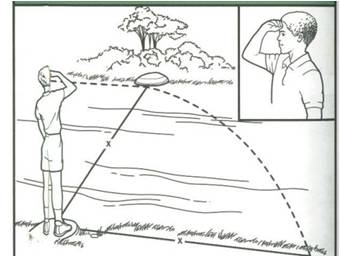
|
|
As noted above, the Salute Method is an easy way to quickly determine the width of an object. However, there is another, more accurate way
to determine the width of an object. There’s just more numbers involved.
|
I don’t like numbers – The Stick Method
Another way to determine the width of an object is by using the Stick Method. This method should not be confused with another method of the
same name that is used to determine height. The Stick Method also extrapolates the width of an object but with better accuracy.
1. Start by standing on the side of the river and locating an object on the opposite side (A).
2. Place a stick in the ground directly opposite of the object on the side of the river you are currently on (B).
3. Turn 90 degrees and walk approximately 20 steps (10 paces) and place a stick at where you end. (C) While the image below shows 50 paces certain circumstances may not allow you to take 50 paces.
4. Continue walking in the same direction taking the same number of paces and place a stick at where you end (D).
5. Turn another 90 degrees (your back should be towards the river) and walk until you can draw a straight line from object A through stick C and ending at your location (E). (A-C-E).
6. Measure the distance between your current location and stick D to determine the width of the object.
|
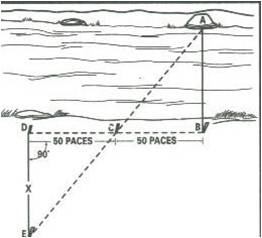
|
|
It’s a magical compass, it can tell you width – The Compass Method
Not really, it’s more math than magic. The Compass Method allows the user to determine the width of an object using some basic mathematics.
Try this exercise:
1. Locate an object on the other side of a river.
2. On your side of the river take out your compass and point the Direction of Travel Arrow towards the object.
3. Turn the bezel to 45 degrees and walk towards your left until the magnetic needle is boxed within the Orienteering Arrow.
4. Once boxed, pace the distance traveled to determine the width of the river.
|

|
|
Height
Now that you know how to find widths, we can focus our attention to heights. There are many methods that can be used to find the height
of an object, but the most common one is the Felling method or the Stick/Pencil Method
|
Just cut the tree down to see how tall it is. – Felling Method
While that may be an option, we can’t cut down every tree we see just to find out how tall it is. Instead we can use the Felling Method that
mimics cutting the tree down. Note: Trees will not be harmed when using the Felling Method. The Felling Method requires you to have access to
the base of the object. This method cannot be used if you are attempting to determine the height of an object across the river. To use the Felling
Method, follow the noted steps:
1. Back away from the object and hold a stick upright at arm’s length ensuring the top of the stick appears to touch the top of the object. Note: if your stick is too small, you are not far enough from the object.
2. Turn the stick 90 degrees so it is lined up with the horizon simulating that the object has fallen, hence the term “felling.”
3. Have your buddy stand at the location where the tip of the stick ends.
4. Pace the distance between the marker and the base of the object to determine the height.
|
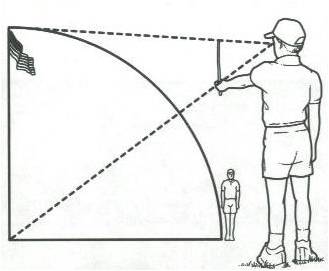
|
|
Stick Method…Again – Stick (Pencil) Method
The Stick Method, not to be confused with the Stick Method used to estimate the width of an object, is also known as the Pencil Method.
This method is used to estimate the height of an object. To use the Stick Method, follow the noted steps:
1. Have a friend (whose height is known) stand beside the object to be measured.
2. Hold a pencil or stick at arm’s length and with one eye, move your pencil or stick up and determine the number of stick required to cover the entire height of the object.
3. Multiply the number obtained from step 2 with the height of your friend to determine the height of the object.
|
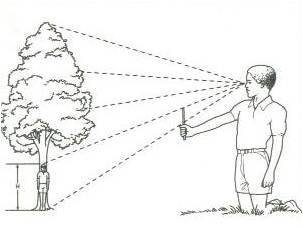
|
|
These are just basic techniques used to estimate height, width, and distance. It is used when using a measuring tape is just not practical.
Since these techniques are just estimation, a scout should conduct the estimation multiple times to determine whether errors were introduced.
As the scouts use these techniques more and more, the accuracy of the results should improve.
|





